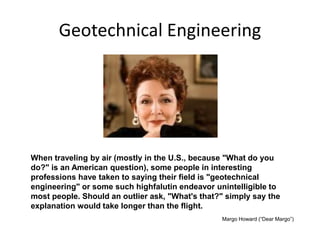The Definitive Guide for Geotheta
The Definitive Guide for Geotheta
Blog Article
Geotheta Can Be Fun For Anyone
Table of ContentsFascination About GeothetaEverything about GeothetaGeotheta Fundamentals ExplainedThe Ultimate Guide To GeothetaThe Only Guide to Geotheta

They conduct website examinations, gather examples, do research laboratory examinations, and analyze information to review the viability of the ground for construction jobs - Engineer of Record. Based on their searchings for, geotechnical engineers provide suggestions for structure layout, slope stability, maintaining frameworks, and mitigation of geotechnical dangers. They team up with various other experts, such as architects, architectural designers, and construction teams, to make sure that geotechnical factors to consider are incorporated into the overall project layout and execution
By examining the habits and residential or commercial properties of soil and rock, they can determine potential geotechnical risks such as landslides, soil negotiation, or incline instability. Their knowledge aids avoid failures or crashes that might jeopardize lives and residential property. Here are some in-depth duties and obligations of a geotechnical designer: Website Examination: Geotechnical engineers conduct site investigations to collect data on subsurface problems.
They analyze the data to understand the residential or commercial properties and actions of the soil and rock, including their stamina, permeability, compaction qualities, and groundwater conditions. Geotechnical Evaluation and Design: Geotechnical designers assess the information gathered during website examinations to examine the stability and suitability of the website for construction projects. They carry out geotechnical computations and modeling to review aspects such as bearing capability, negotiation, slope security, lateral planet pressures, and groundwater flow.
The 8-Second Trick For Geotheta
Structure Design: Geotechnical designers play a crucial duty in creating structures that can securely sustain the designated structure. They evaluate the dirt problems and lots demands to figure out the proper foundation kind, such as superficial structures (e.g., footings), deep foundations (e.g (https://pubhtml5.com/homepage/jugmn/)., heaps), or specialized strategies like dirt enhancement. They take into consideration factors such as negotiation limitations, birthing capability, and soil-structure communication to create optimal foundation styles
They assess building and construction plans, screen site tasks, and perform field evaluations to validate that the style suggestions are complied with. If unforeseen geotechnical concerns develop, they examine the scenario and offer suggestions for remediation or adjustments to the design. Risk Analysis and Reduction: Geotechnical designers assess geotechnical threats and risks related to the project website, such as landslides, liquefaction, or dirt disintegration.

Collaboration and Interaction: Geotechnical engineers function closely with other experts included in a task, such as designers, architectural engineers, and building groups. Reliable interaction and collaboration are important to incorporate geotechnical considerations into the overall project style and building process. Geotechnical designers give technological expertise, response queries, and guarantee that geotechnical requirements are met.
Things about Geotheta
Below are some kinds of geotechnical designers: Structure Designer: Structure designers focus on developing and assessing foundations for structures. They examine the soil conditions, lots needs, and site attributes to identify one of the most appropriate foundation type and style, such as shallow structures, deep foundations, or specialized techniques like heap structures.
They assess the variables influencing incline security, such as soil homes, groundwater conditions, and slope geometry, and create techniques to avoid incline failures and alleviate risks. Quake Designer: Earthquake designers specialize in assessing and developing structures to stand up to seismic pressures. They analyze the seismic hazard of a site, evaluate soil liquefaction potential, and develop seismic layout criteria to ensure the security and strength of frameworks during earthquakes.
They perform area testing, collect samples, and assess the gathered data to characterize the soil residential properties, geologic formations, and groundwater conditions at a website. Geotechnical Instrumentation Designer: Geotechnical instrumentation designers concentrate on surveillance and measuring the habits of dirt, rock, and frameworks. They install and keep instrumentation systems that keep track of aspects such as dirt negotiation, groundwater levels, slope movements, and architectural displacements to evaluate efficiency and give early warnings of possible concerns.
The Greatest Guide To Geotheta
They conduct tests such as triaxial examinations, debt consolidation examinations, direct shear tests, and permeability examinations to gather information for geotechnical evaluation and layout. Geosynthetics Engineer: Geosynthetics engineers specialize in the layout and application of geosynthetic materials, such as geotextiles, geogrids, and geomembranes. They utilize these products to improve soil stability, reinforce inclines, give drain remedies, and control disintegration.
They tend to be investigatory people, which implies they're intellectual, reflective, and investigative. They are interested, systematic, rational, logical, and logical. Some of them are likewise social, suggesting they're kind, charitable, participating, person, caring, helpful, compassionate, tactful, and friendly - Consulting Engineers.
In the workplace environment, geotechnical engineers use specialized software application tools to execute computations, develop layouts, and analyze information. They prepare reports, testimonial project requirements, connect with customers and staff member, and coordinate task activities. The workplace setting offers a favorable setting for research study, evaluation, and cooperation with other professionals associated with the task.
Examine This Report on Geotheta
They often go to project sites to conduct website examinations, evaluate geotechnical conditions, and collect data for analysis. These brows through involve traveling to different places, often in remote or tough surfaces. Geotechnical engineers important site might execute dirt sampling, conduct tests, and monitor building activities to ensure that the geotechnical aspects of the job are being implemented appropriately.
Geotechnical engineers also function in specialized geotechnical research laboratories. Geotechnical lab designers function extensively in these environments, managing screening tools, running instruments, and tape-recording information.
Report this page